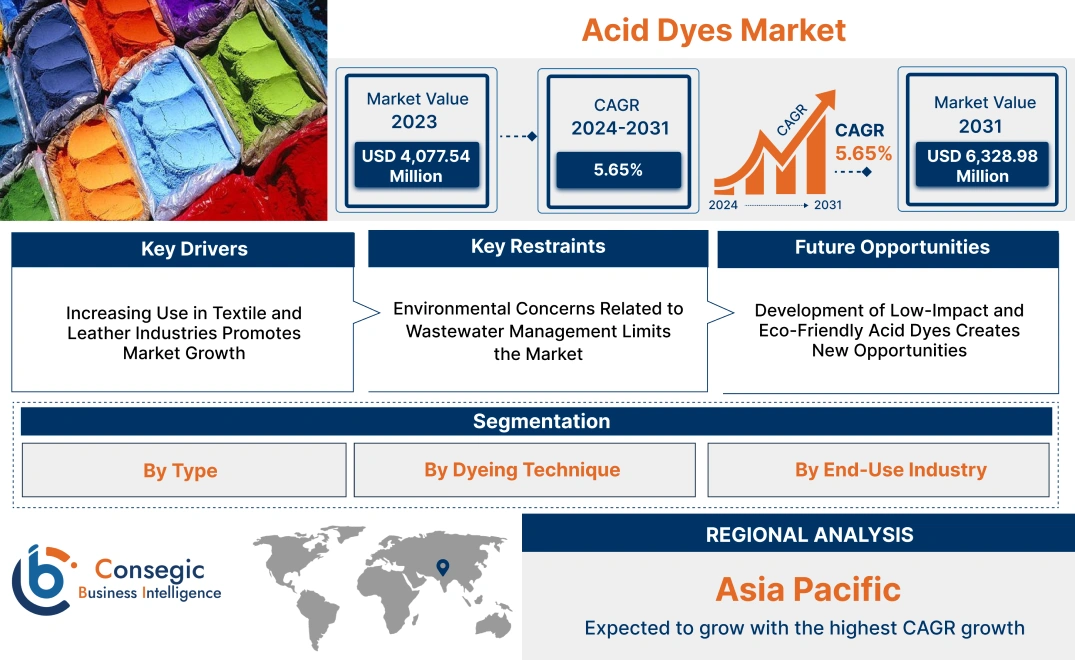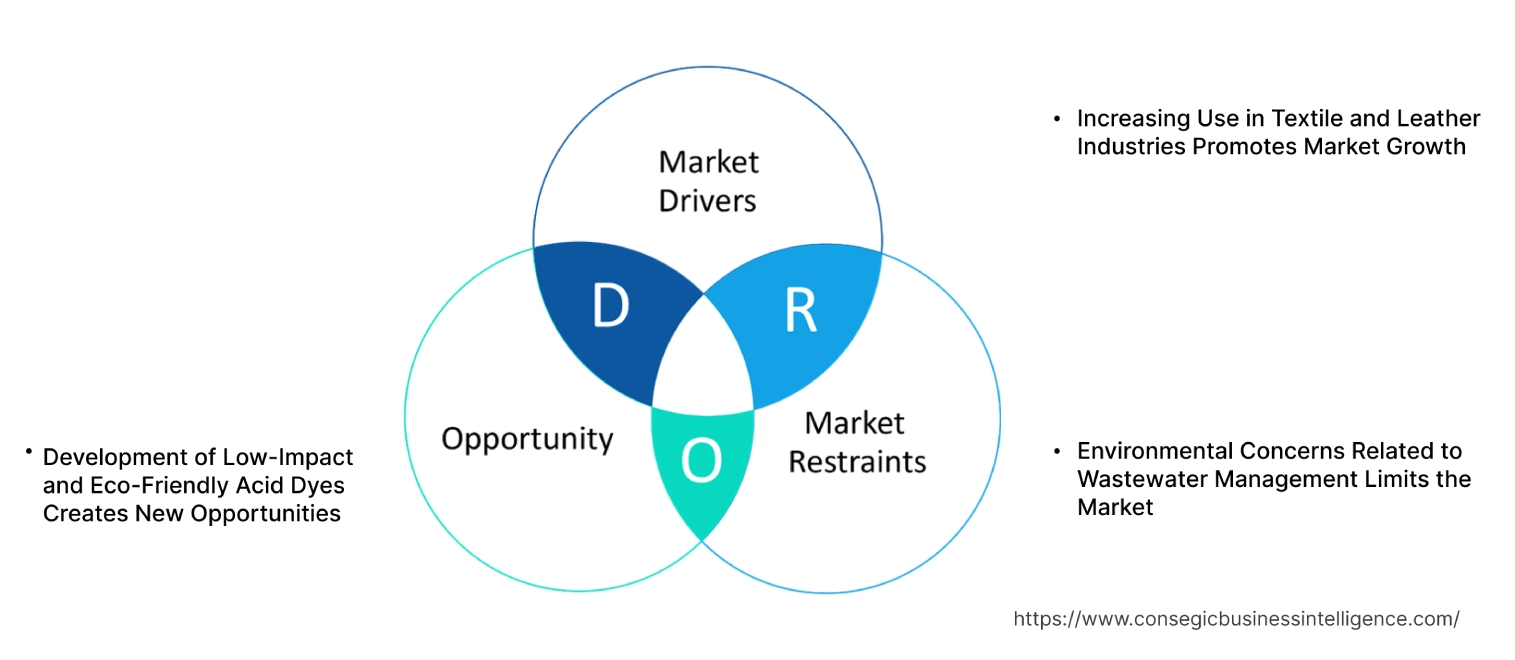- Summary
- Table Of Content
- Methodology
Acid Dyes Market Size:
Acid Dyes Market size is estimated to reach over USD 6,328.98 Million by 2032 from a value of USD 4,077.54 Million in 2024 and is projected to grow by USD 4,235.26 Million in 2025, growing at a CAGR of 5.65% from 2025 to 2032.
Acid Dyes Market Scope & Overview:
Acid dyes refer to synthetic, water-soluble dyes characterized by anionic properties and affinity for protein fibers and synthetic polyamides. These dyes exhibit bright shades, excellent leveling properties, and good wash-fastness, ensuring vibrant and durable coloration. They deliver reliable performance in textile dyeing, leather finishing, ink formulations, and specialty applications. Additionally, acid dyes support reproducible results, enhanced penetration, and uniform dye distribution across various substrates. The product accommodates a wide spectrum of shades, allowing flexibility in design and product differentiation. Major end-use industries include textiles, leather goods, and paper manufacturing, with growing interest in fibers like wool, silk, and nylon. The market responds to evolving environmental regulations through sustainable formulations, reduced effluent load, and adherence to stringent quality standards. This ongoing innovation supports consistent demand and growth across diverse global markets.
Key Drivers:
Increasing Use in Textile and Leather Industries Promotes Market Growth
Acid dyes are extensively utilized in the textile and leather industries due to their ability to produce vibrant, long-lasting, and diverse colors. These dyes are particularly effective on protein-based fibers such as wool, silk, and nylon, making them an essential component for creating high-quality apparel, upholstery, and decorative fabrics. In the leather sector, acid dyes are employed to enhance the aesthetic appeal of products such as shoes, bags, and accessories, offering superior colorfastness and a wide range of shades.
The rising emphasis on customization and premium-quality materials in fashion and interior design has further elevated the importance of acid dyes. Trends in eco-conscious manufacturing have also pushed the sectors toward improved dyeing processes that maximize efficiency and minimize waste. Acid dyes, known for their compatibility with advanced dyeing techniques, are increasingly aligned with these evolving sectors' practices, reinforcing their critical role in textile and leather applications.
Key Restraints :
Environmental Concerns Related to Wastewater Management Limits the Market
The production and application of acid dyes present significant environmental challenges, particularly concerning wastewater management. Dyeing processes often generate large volumes of effluent containing toxic and non-biodegradable components, such as heavy metals and synthetic additives. This wastewater, if not treated effectively, can harm aquatic ecosystems and pose risks to public health.
Addressing these issues requires the implementation of advanced treatment systems to remove pollutants and ensure regulatory compliance. However, the high costs associated with these technologies create a barrier for smaller manufacturers, limiting their ability to adopt acid dyes sustainably. Trends in environmental regulations and corporate responsibility are prompting the sectors to explore innovative solutions for wastewater reduction and recycling, but these efforts require substantial investments and cross-sector collaboration.
Future Opportunities :
Development of Low-Impact and Eco-Friendly Acid Dyes Creates New Opportunities
The shift toward sustainability in the dyeing industry has created opportunities for the development of low-impact and eco-friendly acid dyes. Innovations in dye chemistry are enabling the production of biodegradable dyes and formulations that require less water and energy during the dyeing process. These advancements in trends not only reduce the environmental footprint of acid dyes but also cater to the rising consumer preference for sustainable and ethically produced products.
Additionally, eco-friendly acid dyes are being tailored for use in advanced dyeing techniques, such as digital printing and low-temperature processes, which further enhance their appeal in industries seeking to improve operational efficiency. Trends in green manufacturing and sustainability-focused branding highlight the potential of these dyes to capture market interest, making them a promising avenue for innovation and the acid dyes market expansion in the acid dyes market.
Acid Dyes Market Segmental Analysis :
By Type:
Based on type, the market is segmented into strong acid dyes, weak acid dyes, and neutral acid dyes.
The strong acid dyes segment accounted for the largest revenue of 42.60% in the acid dyes market share in 2024.
- Strong acid dyes are widely used in the textile sectors for dyeing protein fibers such as wool, silk, and nylon.
- These dyes are highly valued for their ability to produce vibrant and uniform colors with superior fastness properties.
- Their compatibility with a wide range of dyeing techniques makes them a preferred choice in the production of apparel and home textiles.
- The increasing advancement for high-quality and visually appealing textile products in the global fashion industry is driving the growth of this segment.
- Strong acid dyes market analysis leads the segmental trends due to their widespread use in the textile sector and their ability to deliver vibrant and durable colors.
The neutral acid dyes segment is anticipated to register the fastest CAGR during the forecast period.
- Neutral acid dyes are gaining traction in applications requiring balanced dyeing performance, including excellent color fastness and even distribution.
- These dyes are primarily used for dyeing silk and wool blends, which are popular in high-end textiles.
- The growing preference for luxury fabrics and the increasing acid dyes market opportunities and advancement for eco-friendly dyeing processes are driving the adoption of neutral acid dyes.
- Neutral acid dyes are expected to grow rapidly due to their use in luxury textiles and the rising focus on sustainable dyeing practices.
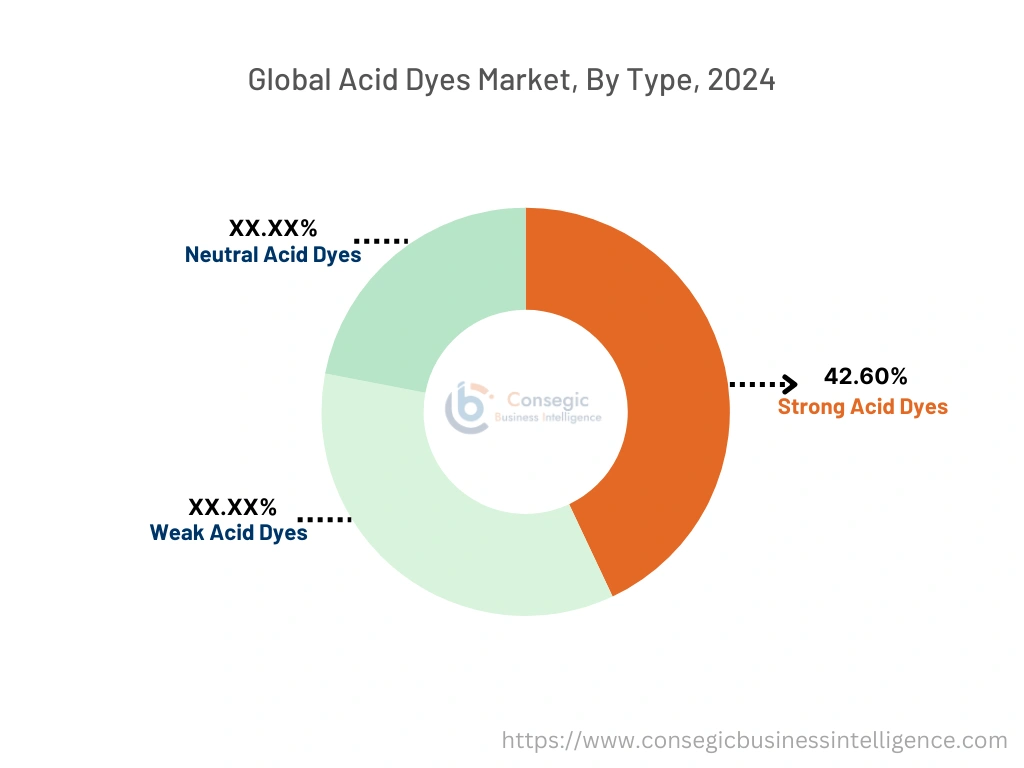
By Dyeing Technique:
Based on dyeing techniques, the market is segmented into exhaust dyeing, pad dyeing, loose stock dyeing, yarn dyeing, and printing.
The exhaust dyeing segment accounted for the largest revenue in acid Dyes market share in 2024.
- Exhaust dyeing is one of the most common techniques used for acid dyes, particularly for wool, silk, and nylon fibers.
- This technique ensures deep and uniform penetration of dye into the fabric, resulting in superior color intensity and fastness.
- The dominance of this technique is driven by its efficiency and widespread use in mass textile production, particularly in apparel manufacturing.
- Exhaust dyeing dominates the acid dyes market trends due to its efficiency and ability to deliver high-quality results in mass textile production.
The printing segment is anticipated to register the fastest CAGR during the forecast period.
- Acid dyes are increasingly used in textile printing applications, particularly for creating intricate and colorful designs on fabrics such as silk and nylon.
- The rising popularity of customized and digitally printed textiles is driving growth in this segment.
- Additionally, advancements in printing technologies that enable precise and efficient application of acid dyes are further boosting demand.
- Printing segment analysis is expected to grow rapidly due to the rising demand for customized textiles and advancements in digital printing technologies.
By End-Use Industry:
Based on end-use, the market is segmented into textiles, leather, paper, food & beverages, and others.
The textiles segment accounted for the largest revenue share in 2024.
- The textile sector is the largest consumer of acid dyes, as these dyes are extensively used for dyeing natural and synthetic fibers.
- Their vibrant color range, excellent fastness, and compatibility with various dyeing techniques make them indispensable in apparel, home textiles, and industrial fabrics.
- The increasing acid dyes market demand for colorful and durable textiles, driven by acid dyes market growth in the fashion and home décor industries, supports the dominance of this segment.
- Textiles dominate the acid dyes market trends due to the extensive use of acid dyes in producing vibrant and durable fabrics for apparel and home textiles.
The food & beverages segment is anticipated to register the fastest CAGR during the forecast period.
- Acid dyes are increasingly used as colorants in the food and beverage sectors for products such as candies, beverages, and processed foods.
- The growing focus on aesthetic appeal and consumer preference for visually appealing products is driving this segment.
- Additionally, the acid dyes demand for natural and safe food colorants is expected to further boost the adoption of acid dyes in this sector.
- Food & beverages are expected to grow rapidly due to the rising advancement of visually appealing products and increasing adoption of safe, food-grade acid dyes.
Regional Analysis:
The regions covered are North America, Europe, Asia Pacific, the Middle East and Africa, and Latin America.
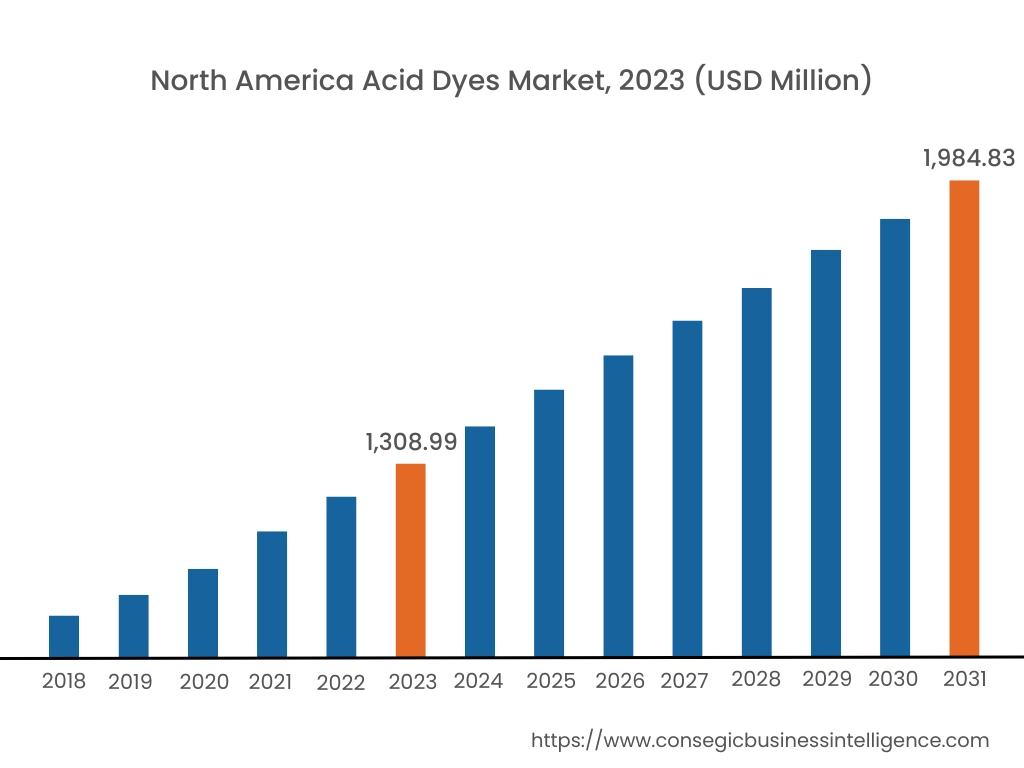
In 2024, North America was valued at USD 1,352.55 Million and is expected to reach USD 2,051.22 Million in 2032. In North America, the U.S. accounted for the highest share of 72.40% during the base year of 2024. North America holds a significant share in the acid dyes market analysis, driven by its application in textiles, leather, and industrial dyeing processes. The U.S. leads the region with a strong surge for acid dyes in the production of high-quality textiles and carpets, as well as their increasing use in the cosmetics and personal care industries for coloring products like shampoos and lotions. Canada contributes to the market with its adoption of acid dyes in niche applications such as food packaging and inks. However, stringent environmental regulations on dye effluents and wastewater treatment may pose challenges to manufacturers in the region.
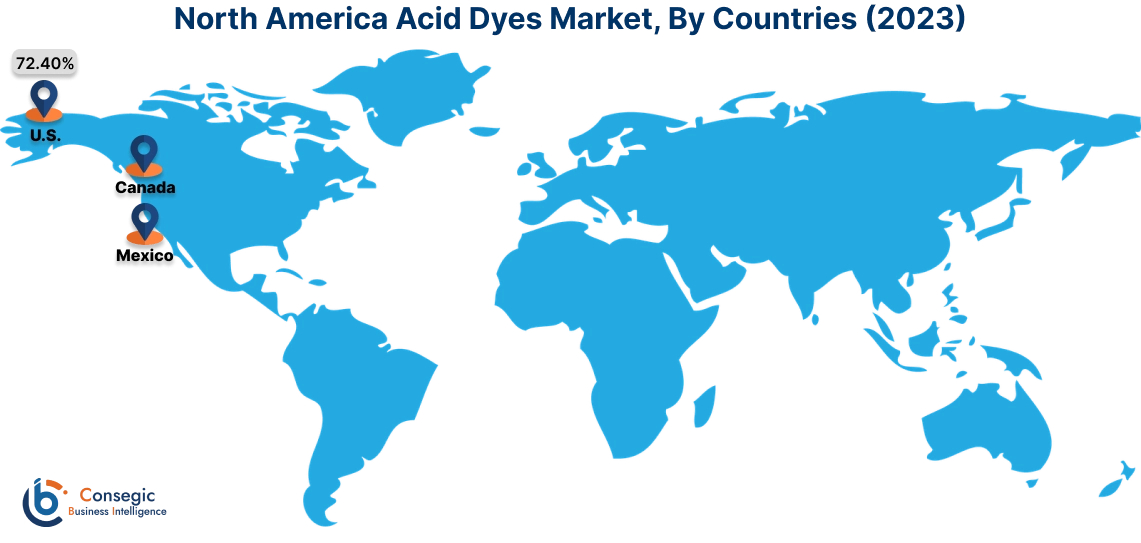
In Asia Pacific, the market is experiencing the fastest growth with a CAGR of 6.1% over the forecast period. Asia-Pacific is the largest and fastest-growing region in the acid dyes market, driven by rapid industrialization and the expansion of textile and leather manufacturing in China, India, and Bangladesh. China dominates the market with its large-scale production of textiles and increasing use of acid dyes in apparel and home furnishing fabrics as per the analysis. India’s growing textile exports and traditional dyeing industries further support the demand for acid dyes. Bangladesh, a global hub for garment manufacturing, relies on acid dyes for high-quality textile finishing. However, environmental concerns over untreated dye effluents and the lack of stringent regulations in some areas may impact the market.
Europe is a prominent market for acid dyes, supported by the region's advanced textile and leather industries, as well as its focus on eco-friendly production processes. Countries like Germany, Italy, and France are key contributors. Germany's textile and automotive sectors drive the use of acid dyes for fabric and leather coloring, while Italy emphasizes their application in premium leather goods and footwear. The regional analysis shows France focuses on acid dyes for high-end fashion textiles and cosmetics. However, strict EU regulations on hazardous chemicals and environmental sustainability create compliance challenges for manufacturers.
The Middle East & Africa region is witnessing steady growth in the acid dyes market, driven by increasing demand for textiles and leather products. In the Middle East, countries like Saudi Arabia and the UAE are adopting acid dyes for fabric dyeing in traditional garments and home textiles. In Africa, South Africa is an emerging market, with acid dyes used in the production of textiles for both domestic consumption and export. However, limited local manufacturing capabilities and reliance on imports for dyes may restrict acid dyes market growth in certain parts of the region.
Latin America analysis portrays it as an emerging market for acid dyes, with Brazil and Mexico leading the region. Brazil’s textile and leather industries are key drivers, with acid dyes used extensively in apparel and footwear production. Mexico’s expanding automotive and furniture industries also adopt acid dyes for leather coloring in seats and upholstery. The region is increasingly focusing on sustainable dyeing practices to align with global environmental trends. However, economic instability and inconsistent regulations on industrial effluents may hinder broader market adoption.
Top Key Players and Market Share Insights:
The acid dyes market is highly competitive with major players providing products and services to the national and international markets. Key players are adopting several strategies in research and development (R&D), product innovation, and end-user launches to hold a strong position in the global acid dyes market. Key players in the acid dyes industry include -
- Atul Ltd. (India)
- BASF SE (Germany)
- Setas Color Center (Turkey)
- Rudolf GmbH (Germany)
- Zhejiang Runtu Co., Ltd. (China)
- Gayatri Group (India)
- Clariant International Ltd. (Switzerland)
- Huntsman International LLC (USA)
- Kiri Industries Ltd. (India)
- Camex Limited (India)
Recent Industry Developments :
Innovations:
- In December 2024, Kyung-In Synthetic Corporation (KISCO), a South Korean conglomerate, is advancing sustainability in textile dye production through several initiatives such as Sustainable Manufacturing: KISCO implements eco-friendly processes, surpassing regulatory standards for air emissions and wastewater discharges, ensuring environmental protection.
Acid Dyes Market Report Insights :
| Report Attributes | Report Details |
| Study Timeline | 2019-2032 |
| Market Size in 2032 | USD 6,328.98 Million |
| CAGR (2025-2032) | 5.65% |
| By Type |
|
| By Dyeing Technique |
|
| By End-Use Industry |
|
| By Region |
|
| Key Players |
|
| North America | U.S. Canada Mexico |
| Europe | U.K. Germany France Spain Italy Russia Benelux Rest of Europe |
| APAC | China South Korea Japan India Australia ASEAN Rest of Asia-Pacific |
| Middle East and Africa | GCC Turkey South Africa Rest of MEA |
| LATAM | Brazil Argentina Chile Rest of LATAM |
| Report Coverage |
|
Key Questions Answered in the Report
What is the projected market size of the Acid Dyes Market by 2031? +
Acid Dyes Market size is estimated to reach over USD 6,328.98 Million by 2032 from a value of USD 4,077.54 Million in 2024 and is projected to grow by USD 4,235.26 Million in 2025, growing at a CAGR of 5.65% from 2025 to 2032.
What drives the demand for acid dyes in the textile and leather industries? +
Acid dyes are highly favored for their ability to produce vibrant and durable colors, particularly for protein fibers like wool, silk, and nylon. Their application in high-quality textiles, leather goods, and home décor drives demand, supported by trends in customization and eco-conscious manufacturing.
Which type segment dominates the Acid Dyes Market? +
The strong acid dyes segment holds the largest revenue share due to its extensive use in textile applications, offering vibrant colors, high colorfastness, and compatibility with various dyeing techniques.
What are the primary challenges faced by the Acid Dyes Market? +
Environmental concerns related to wastewater management, containing toxic components from dyeing processes, pose significant challenges. High costs for advanced treatment technologies and stringent regulations also impact the market.
Which dyeing technique is most widely used? +
The exhaust dyeing technique dominates the market due to its ability to deliver uniform and deep dye penetration, making it a preferred choice for mass production of textiles like wool and silk.
